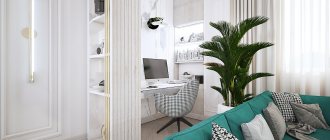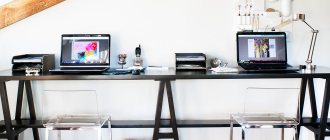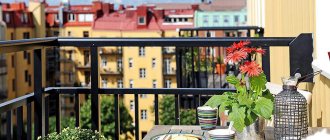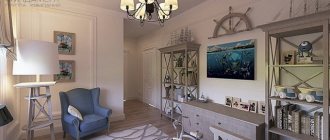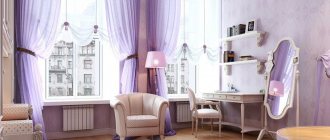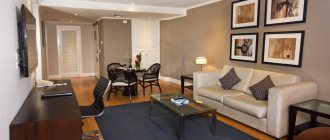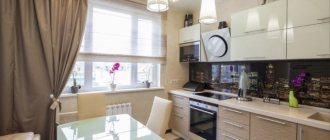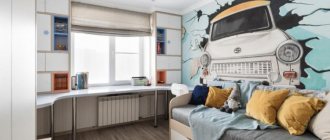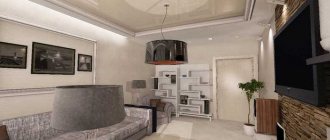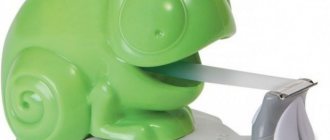Color scheme for decorating a teenage room
Everyone knows that adolescence for a person is one of the most difficult psychologically. This is the time when there is a serious restructuring of the body, due to which sharp jumps in the psycho-emotional sphere are observed, the mood may change ten times a day, and even depressive states may appear. Therefore, it is extremely important to provide a neutral background for decoration and furniture in a teenager’s room, avoiding a gloomy wallpaper background, for example. You should not hang scary posters and pictures in a visible place. If a child really wants to place something like this in his room, you can allocate an inner closet door for this purpose, for example. But it is better to rid the room of everything negative that carries a negative worldview.
For walls and ceilings, it is better to choose neutral colors - white, beige, light gray, blue, green. It is better not to use bright colors - red, burgundy, orange, neon in large areas, because this can negatively affect the psychological state and make the child more aggressive. It is better to use bright interior details as accents to create a favorable emotional background for the room.
Sports area
During adolescence, many children become interested in sports. And even though this hobby is not professional, both girls and boys try to look after their figure and devote at least a little time to fitness, yoga or stretching every day. Therefore, a sports area, even if small, should be in every teenager’s room. Here you can place a wall bars, a mat or yoga mat, a fitball, place dumbbells, expanders and other sports equipment. Even if the child is not very keen on sports and is more drawn to other activities, the presence of such a zone in his room will remind him that it is time to warm up and devote some time to physical exercise.
How to properly organize storage?
To make it comfortable for a child to do homework, the tabletop should remain as free as possible. At the same time, access to all necessary office supplies, books, and educational materials should remain simple and convenient.
That is, it is necessary to organize storage areas directly in the work area - here, like in the kitchen, walking from the table to the cabinet across the entire room will be extremely inconvenient.
Help to maintain order:
- Desk drawers. Small items are stored in them, as well as things that are used constantly: pens, pencils, markers, scissors, paper clips, notebooks.
- Open shelves. Typically used for books, albums, notebooks.
- Closed storage systems. They hide items that are not in daily “demand”: sketchbooks, paints, plasticine, supplies of office paper. The printer is also put away here so that large equipment does not get in the way on the table.
Advice! There are no drawers in the table? Hang a railing with cups above it - it’s convenient to put pens, felt-tip pens, and pencils in them. And if you add a few hooks, the problem of storing scissors or glasses will be solved. Instead of railing, perforated boards are used: compact for all their versatility.
Creative area
Does your child like to draw or sew? Or maybe he loves assembling lego structures or even soldering microcircuits? All these are creative impulses that must be encouraged and not ignored. It is in childhood and adolescence that an attachment to a business often arises, which can develop into a profession and become a part of a person’s life. That is why it is so important to properly organize an area for your child’s favorite activities, where he can relax his soul and engage in his favorite hobby.
The creative area may be small, but it should have everything you need. Usually this is a table, a chair and a place to place the necessary accessories. If, for example, a teenager loves to sew, you will need to install a sewing machine, convenient organizers and drawers for sewing supplies, you can put a rack nearby for ready-made outfits or even a mannequin for fitting. The more professionally you approach the issue, the more seriously the child will take the matter. And when a teenager sees that his work is respected and taken seriously, then the approach will be different, he also begins to treat his hobby with great attention and tries to improve in it.
Rest zone
Creating a comfortable relaxation area is the most important task when planning the design of a children's room, including for a teenager. Often schoolchildren and students devote a lot of time and attention to study, entertainment, and communication, so there is not much time left for sleep. Therefore, the sleeping area should be as thoughtful as possible - it is important to pay great attention to choosing a comfortable bed according to age and its location in the room.
It is advisable that the relaxation area be separated from the study area and the active area for sports and games, otherwise it will be quite difficult to establish healthy sleep. It’s good if the bed is separated from other spaces in the room, for example, by a canopy or canopy - in this case, nothing will distract the child from a healthy sleep.
A convenient solution for a teenager’s bed can be functional pockets on the headboard or footboard - you can conveniently place your favorite book, tablet, headphones there for quiet leisure time before bed - this relaxes and puts you in the mood for rest.
An acceptable solution for a teenager’s room would be to choose a loft bed. The child is already dexterous enough to climb onto a hill, and the area under the bed can be organized at your discretion. This saves precious room space, and besides, the teenager gets a completely private area where no one will disturb him unnecessarily.
Reception area
The interior of a teenager's room should meet all his needs. Communication for growing children is a very important component of their development and favorable emotional background. Therefore, it is completely natural when a teenager wants to invite friends to his home for communication, games, and watching his favorite films.
It is advisable that the area for receiving guests be separate from the area for study and relaxation. It is not very good when guests sit on the child’s bed where he sleeps. It would be good if there was room in the room for a small corner sofa and a coffee table where children could play board games, drink tea and have a snack. Teenagers love to imitate adults, and such gatherings will help develop communication skills, and subsequently they will remember some of the brightest and kindest moments from childhood.
It would be good if there was some kind of stand for board games or magazines in the guest area. When guests arrive for the first time, they need to be occupied, and if the child is shy, this can create an awkward situation where you have to quickly come up with ways to entertain others. Such hint places will keep guests occupied and create a relaxed atmosphere. You can put a small vase with sweets or dried fruits on the table.
If children like to visit each other for overnight stays, it is important to provide a sleeping place for the guest. It is better to choose the same corner sofa with a transformation function so that it turns into a full-fledged place to sleep.
Children's workplace: arrangement rules
Step 1. Zoning
The first thing you will encounter when organizing a work area is the choice of location and its zoning. With the right decision, the student will be isolated from all the temptations present in the nursery and will be able to concentrate directly on the work process.
Zoning of a children's workplace
This does not mean that the child should be driven into a remote corner, surrounding the area with a stationary partition. Confinement of space can negatively affect performance. It is better to use for these purposes:
1. Mobile screen.
2. Curtain.
3. Open shelving.
Zoning workplaces using open shelving
As for the choice of location for organizing the study area, then, for obvious reasons, the best option would be a section of the room near the window.
Step 2. Set up the table
If possible, the table should be placed with the left end facing the window. For left-handers, this rule is exactly the opposite. They need the light to fall from the right, therefore, the table will have to be turned 180°. It is advisable that the wall be behind the child’s back, and not loom before his eyes.
An adequate solution would be to install a table in front of the window.
The optimal position for a child's desk is in front of the window.
In principle, there is always an opportunity to successfully arrange one table in a nursery, but what to do if there are two students? For this case, there are also several schemes for arranging a children's workplace. Tables can be placed:
1. Single row.
2. In parallel.
3. L-shaped.
Everything will depend on the layout of the room itself and the number of windows in it.
With a single-row arrangement between children's tables, you can make a passage or separate them with a piece of furniture, a screen, etc. This step will help students not distract each other from doing their work.
Single-row arrangement of children's tables
With tables arranged in parallel, for the same purpose, it is enough to simply seat the children with their backs to each other.
Parallel arrangement of children's desks
In an L-shaped layout, it is not necessary to use two separate tables. You can buy one corner.
Corner workplace for two children
Step 3. Selecting a table
Design
“The presence of a toy in a child’s workplace will create a specific mood that in no way corresponds to the assigned tasks.”
The main point in choosing a table is its suitability for the child’s age. If you plan to install a computer in your work area, place it on a separate table. Why? The problem is children's perception of this accessory. They look at the computer as a means of entertainment and define it, especially at an early age, as a toy. The presence of a toy in a child’s workplace will create a specific mood that does not in any way correspond to the assigned tasks. In addition, a desktop computer requires a table of a non-standard design with a retractable panel for the keyboard and other nuances. In a small area, it is permissible to use a corner table, which allows you to allocate an area for writing and installing a laptop.
A corner desktop will solve the problem with installing a computer
When choosing a desk model, look for options with tabletop adjustments. It will be much more convenient for the child to write if it can be installed at an angle. At such a table it will be much more comfortable to draw and draw.
Children's table with adjustable top
Dimensions
The table should have proportions that suit your child. This model can be considered an option where the table top is located just below chest level and when sitting at which the child has the opportunity to comfortably rest his elbows on it without raising his shoulders or slouching. For kids with a height of up to 120 cm, you should look for tables with a height of up to 52 cm. For teenagers, designs with a height of up to 61 cm are suitable. The “adult” standard is tables with a height of 75 cm.
Table size according to child's height
The ideal table model is considered to be a transformable design with the ability to adjust the height of the tabletop and adjust its position. This is a purchase for the ages. With such a children's workplace, your child will not only graduate from school, but will also work as a student.
Children's transforming table
Material
Don’t chase the exotic and don’t become hostage to the interior style. You should not take your child to glass or plastic tables. Besides the fact that they seem fragile, they are really cold and have a slippery surface. It is better to remain conservative in this matter and buy a standard wooden model of good quality. When inspecting the product you are interested in, make sure that there are no cracks, untreated areas, traces of glue or other defects. The reason to leave a table in a store is the unpleasant smell emanating from it. As a temporary option, an economy class table made of laminated chipboard can be purchased.
Reliable children's desk made of wood
You should not experiment with the design either. Take a standard rectangular table that stands firmly on legs, has a back panel and a built-in cabinet.
In a small nursery, where installing a regular table is problematic, you can solve the issue of arranging a children's work area in other ways. For example, converting a window sill into a study table.
Organization of a children's workplace on the windowsill
This is done by replacing the standard window sill with a deeper countertop. Under it you can place a free-standing mobile cabinet. A series of holes must be made in the surface of the makeshift table, closer to the window. This is necessary to organize proper ventilation of the area. In the cold season, the heat coming from the radiators will prevent the window from fogging up and molding. For such a specific workplace, you will have to purchase a transforming chair with adjustable seat height and possibly a footrest. The latter can be a low bench or even books.
An interesting option would be a folding table attached to the wall. A hinged lid of a sideboard or bureau can replace a full-fledged table.
Folding children's workplace
Step 4. Choosing a chair
The child will spend a lot of time at the desk, so he should be able to sit comfortably. Stools, poufs, and soft chairs are not suitable for this. The chair you need should have a firm back that has a slight curve to allow your child's back to fit snugly against it. The design of the model should not have armrests. From a medical point of view, the optimal solution would be an orthopedic chair or a regular chair without wheels.
Children's chair with orthopedic back
When sitting on a properly selected chair, your child will keep his knees bent at a precise right angle. In this case, your feet will be completely on the floor, and not resting on your toes. If the last condition is not met, use a stand. A distance of 20–30 cm should be maintained between the table top and the seat of the chair.
Rules for organizing a children's workplace
Teach your child the rules of sitting at a children's workplace. Explain to him that he must keep his back straight, not lean to the sides, lean back, or lean on the tabletop. There should be at least 8 cm of free space between its edge and the student’s chest.
Step 5: Lighting
“Avoid contrast lighting in the children’s workplace”
After the furniture issue has been resolved, it’s time to move on to organizing the lighting. Artificial light must have an adjustable supply. A table lamp should allow directing light flows and have a shade or lampshade. Do not illuminate the child’s workplace with fluorescent lamps and halogen lamps. Stick with sixty-watt incandescent or LED bulbs.
Comfortable table lamp for a child
The rules for supplying artificial light remain the same as for daylight. For left-handers, the lighting device is placed on the right, for right-handers - on the left.
Avoid contrast lighting in the children's workplace. In addition to the table lamp, the room should include sconces or a chandelier with dimmed brightness. This will make the light diffusely soft and prevent children's eyes from getting tired.
If the child's desk is located away from the window, for example, located under a loft bed, then you will have to use a table lamp even during the daytime.
Step 6. Organize your storage system
Work productivity is ensured by many factors, one of which is the order in the child’s workplace. To establish and maintain it, storage systems are designed to be organized in such a way that all items are laid out, as they say, “on shelves” and at the same time are always within reach.
Storage system for children's workplace
The presence of a cabinet and drawers in the table will allow you to place many necessary little things in them. When sorting them, be guided by the principle: the more often a child needs a given item, the closer to him it should be stored. Therefore, in the top drawer of your desktop you should send:
1. Workbooks.
2. Textbooks.
3. Paints and pencils.
4. Sharpener.
5. Rulers.
6. Erasers.
It is possible and even necessary to organize desktop storage systems. Office organizers will cope with this task perfectly. You can put pens, buttons, paper clips in them. Small items can also be stored in transparent plastic containers. A school mini-library can be located on open shelves or in niches.
Desktop storage system for the workplace
For ease of use of the children's workplace, containers and drawers should be signed. This is a great way to not only save time on finding the right accessories, but also teach your child to maintain order.
The following can be permanently located on the desk:
1. Book stand.
2. Lamp.
3. Stationery organizer.
4. Clock.
If desired, a trash can can be placed under the table.
Step 7. Working on the decor
Studying and creativity should be of interest. The child will be happy to spend time at the workplace if he likes it. This means that you will have to start decorating it in order to somewhat personalize the space. You shouldn't get too carried away with the delights. You can add coziness with neutral colors and a small amount of decorative elements. The latter should be thematic and carry a semantic load.
Personalization of children's workplace
A miniature school board, enclosed in a nice frame, will do. You can write a schedule on it, mark important tasks, and place training reminders. The accessory can be wooden or cork. Then all of the above will be written on paper and attached to it with buttons.
Chalk board for children's workplace
You can post the necessary information directly on the tabletop, under plexiglass. A globe will become a trendy decoration for a child’s workplace. In addition to its aesthetic appearance, it will help in studying geography.
You can decorate the area with posters and placards with stimulating inscriptions, mottos, and phrases. A good solution would be interior letters, as well as numbers, which are not difficult to make yourself. They can be mounted on the wall or placed on shelves and niches, and it is not at all necessary to do this in an orderly manner.
Decorating a children's workplace
Step 8: Creative Accessories
Instead of boring scissors and small office supplies, buy your child accessories of unusual shapes and bright colors. It will be much more interesting for a child to put pens in an organizer shaped like a cheerful hedgehog than in a boring glass and fix abstract sheets with multi-colored paper clips. Interesting accessories are not just a waste of money. This is one of the ways to instill interest in the educational process.
Pay attention to the bright children's stationery
